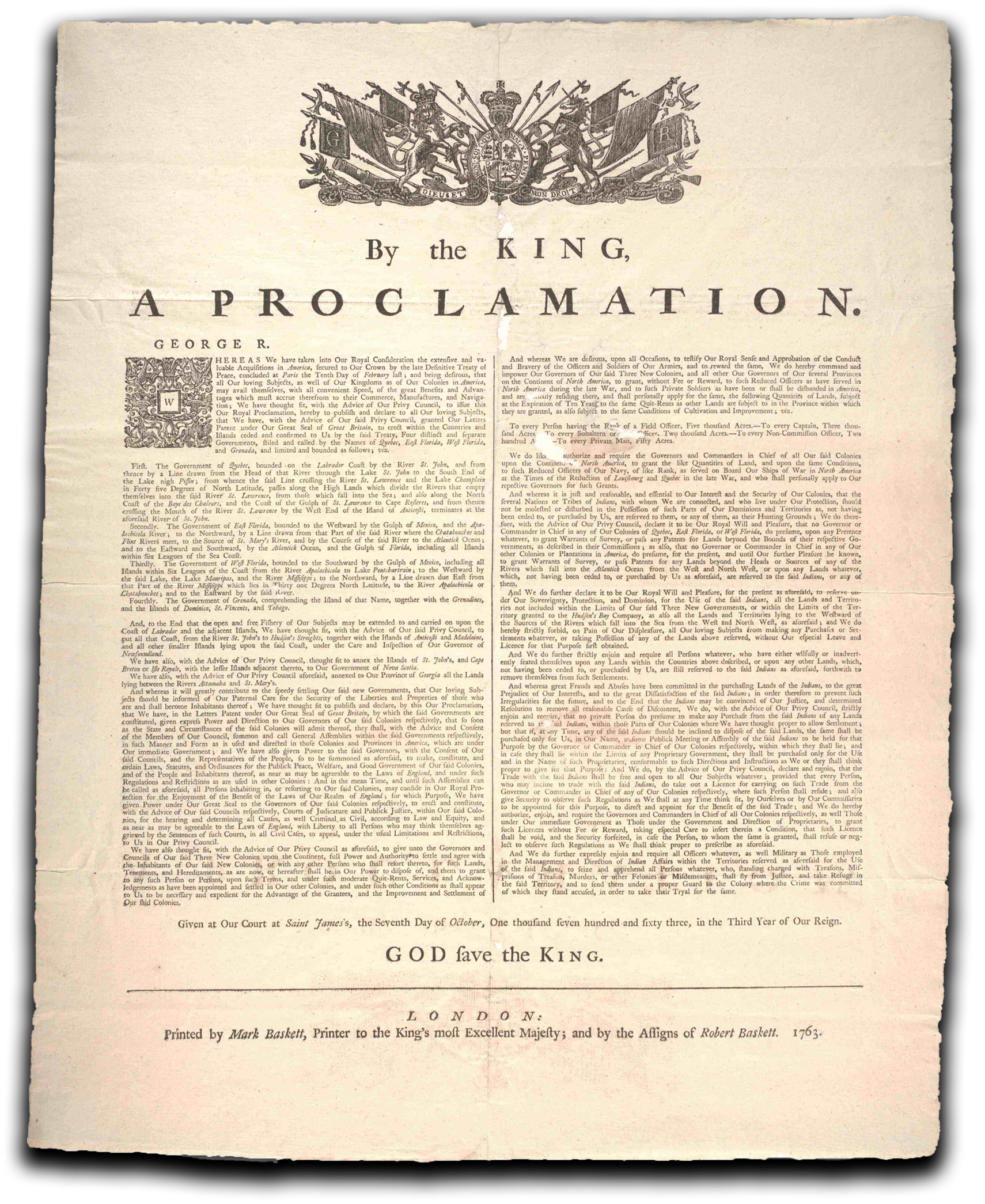1762
- After the British capture Fort de Repentigny in 1761, it is destroyed by a fire. Despite no longer having a fort, the British continue to occupy the Sault Ste. Marie area.
- Pontiac’s Rebellion begins with a meeting on the Detroit River attended by the Ojibwa, Huron, Odawa, and Potawatomi tribes. The Rebellion begins because the Indigenous people of Michigan believe that they were being treated poorly by the British who have ended the gift giving policy of the French in order to save money. The rebellion would end in 1764.

1763
- The Seven Years War ends with the signing of the Treaty of Paris. Despite fighting in the war, the Anishinaabe and other Indigenous peoples are left out of the treaty discussions. The treaty officially ends the French era as Great Britain claims sovereignty over the Great Lakes Region.
- As part of Pontiac’s rebellion, the Ojibwe and Sauk invite the commandant of Fort Michilimackinac to watch a game of baggataway, resulting in the attack on Fort Michilimackinac. At least 27 English men are killed during this surprise battle with dozens more taken captive.
- The Proclamation Line of 1763 is established, prohibiting colonists from settling on any lands west of the Appalachian Mountains. Land sales were also banned between the settler and Native Americans east of the line.

When the Europeans arrived on the North American continent, they brought with them more than just a different belief system and technologies. They also brought with them diseases from which the indigeneous people of “Turtle Island” had no immunity to defend themselves. It is estimated that millions of people in both South and North America died from different diseases brought by Europeans during the 16th and 17th centuries alone. In the 18th and 19th century, diseases such as small pox would make their way to the interior and kill untold numbers of Native Americans, including the Odawa, Ojibwe and Pottawatomi.

Where the transmission of these diseases from Europeans to Native Americans was initially done without any intent, there is evidence in the both the oral tradition and historical record that small pox was used deliberately as a form of germ warfare.
In 1887, Chief Andrew J. Blackbird, of the Odawa tribe in Harbor Springs, Michigan, published his book, “History of the Ottawa and Chippewa Indians.” In it, he conveyed a story that had been passed down to him by his father and other elders.

It was a notable fact that by this time [1763] the Ottawas were greatly reduced in numbers from what they were in former times, on account of the small-pox which they brought from Montreal during the French war with Great Britain. This small pox was sold to them shut up in a tin box, with the strict injunction not to open the box on their way homeward, but only when they should reach their country; and that this box contained something that would do them great good, and their people! … Accordingly, after they reached home they opened the box; but behold there was another tin box inside, smaller. They took it out and opened the second box, and behold, still there was another box inside of the second box, smaller yet. So they kept on this way till they came to a very small box, which was not more than an inch long; and when they opened the last one they found nothing but mouldy particles in this last little box! They wondered very much what it was, and a great many closely inspected to try to find out what it meant. But alas, alas! pretty soon burst out a terrible sickness among them. The great Indian doctors themselves were taken sick and died. The tradition says it was indeed awful and terrible. Every one taken with it was sure to die. Lodge after lodge was totally vacated - nothing but the dead bodies lying here and there in their lodges - entire families being swept off with the ravages of this terrible disease. The whole coast of Arbor Croche... was entirely depopulated.... It is generally believed among the Indians of Arbor Croche that this wholesale murder of the Ottawas by this terrible disease sent by the British people, was actuated through hatred, and expressly to kill off the Ottawas and Chippewas because they were friends of the French Government or French King.
Many American and Canadian scholars believed that the story was apocryphal and was invented to explain the spread of the disease naturally among the Odawa people. However, in the 20th century, letters were discovered that showed that such actions on the part of the British command in America were discussed and probably carried out. On July 7, 1763, the British Commander-in-Chief, Jeffery Amherst, writing to the commander of the besieged Fort Pitt (Pittsburgh,) asked, "Could it not be contrived to send the small pox among those disaffected tribes of Indians? We must, on this occasion, use every stratagem in our power to reduce them?” A week later he wrote again, “You will do well to try to innoculate the Indians by means of blanketts, as well as to try every other method that can serve to extirpate this execreble race.” Though there is no historical evidence that such efforts extended to the Odawa on Lake Michigan, these letters show that the use of germ warfare was not only possible but a sanctioned tactic by the British command.

1776
During the American Revolution, Captain A. S. De Peyster of England sends several Anishinaabe and Menominee troops to recapture Montreal from American forces. However, by the time they arrive at the city, the American troops had already abandoned the city.
1780
During the American Revolution, the British build Fort Mackinac on Mackinac Island fearing that Fort Michilimackinac was to vulnerable to attack. At this time the garrison and fur trade community are all moved as well.
1783
Marking the end of the American Revolution, Great Britain and America sign the Treaty of Paris which stipulates the United States is its own country and has claim to all land east of the Mississippi. This includes the Great Lakes Region. However, Britain still has a great deal of influence in this area. Much like after the Seven Years War, the Indigenous people who fought on both sides of the war are left out of negotiations.
